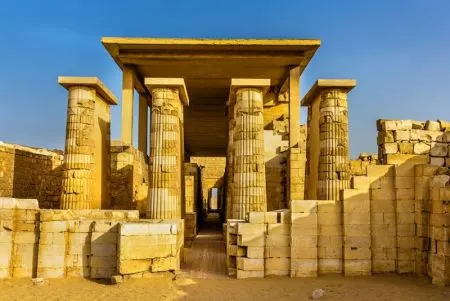Explore the charm of El Moez Street Cairo on an unforgettable Islamic Cairo walking tour. Discover ancient mosques, vibrant bazaars, and rich Egyptian heritage.
The Red Pyramid, also known as the North Pyramid, is a true testament to the architectural prowess of the ancient Egyptians. It stands tall as one of the most well-preserved and fascinating pyramids in Egypt. Built by Pharaoh Sneferu, the father of the famous Khufu, the Red Pyramid is an iconic structure that has captivated the hearts and minds of historians and tourists alike. In this article, we will take an in-depth look at the history, design, and significance of this incredible monument.
A Brief History of the Red Pyramid
The Red Pyramid has its roots in the 4th Dynasty, built by Pharaoh Sneferu, who reigned around the 26th century BC. This remarkable structure was a result of Sneferu's determination to learn from the mistakes made during the construction of his earlier pyramids, such as the Bent Pyramid and the collapsed pyramid at Meidum.
The Red Pyramid was the first successful attempt at constructing a true pyramid, setting the stage for the iconic 4th Dynasty pyramids at Giza. This pioneering effort by Sneferu and his skilled builders laid the groundwork for the future of Egyptian pyramid construction and remains an important part of Egypt's architectural heritage.
Location and Accessibility
One of the major attractions of the Red Pyramid is its relatively serene atmosphere, devoid of the bustling crowds that often swarm the Giza Plateau. Located at Dahshur, a short drive from Saqqara and Cairo, the Red Pyramid is a hidden gem waiting to be explored by avid history enthusiasts and casual tourists alike.
For a long time, the area of Dahshur was off-limits to visitors, which explains the lack of foot traffic at this significant monument. However, today, the Red Pyramid is open to the public, and visitors can enter without any limitations, making it a must-see for those seeking a more intimate experience with ancient Egyptian history.

The Impressive Size and Structure
The Red Pyramid is a formidable structure that boasts an impressive size and design. It is the fourth tallest pyramid in Egypt, standing at a height of 341 feet (104 meters). With a base measuring 722 feet on each side, it is only slightly smaller than the Great Pyramid of Khufu at Giza.
The unique appearance of the Red Pyramid is due to its sides' relatively shallow angle of 43 degrees. This design choice was likely a result of the lessons learned from the construction of the Bent Pyramid, where a change in inclination led to its infamous 'bend.' The builders of the Red Pyramid decided to use the same angle that allowed for the Bent Pyramid's completion, resulting in a squat appearance compared to other pyramids of similar size.
The Red Pyramid's Namesake
The Red Pyramid derives its name from the reddish hue of its limestone core. Most of the pyramid's core is made of red limestone, giving it a distinct appearance that sets it apart from other structures of its time. In addition to the "Red Pyramid" moniker, it is also sometimes referred to as the "Shining" or "Northern Pyramid."

The Foundation and Casing
As the first successful true pyramid, the Red Pyramid showcased the builders' ability to learn from past mistakes and improve upon their techniques. A significant aspect of this improvement was the decision to use several layers of fine white limestone to lay the pyramid's foundation, eliminating the structural issues that plagued earlier pyramids.
To cover the pyramid, Tura limestone was used as casing stones. Although most of the casing has been removed, some still remains, providing valuable insights into the pyramid's construction. For instance, every twentieth casing stone found had inscriptions on the back, with some featuring the cartouche of Sneferu and others naming the various work crews involved, such as the "Green Gang" or the "Western Gang."
These inscriptions have proven vital in understanding not only the timeline of the pyramid's construction but also the work sequence that took place.
The Timeline of Construction
Thanks to the inscriptions found on the casing stones, historians have been able to piece together a rough timeline of the Red Pyramid's construction. It is believed that the pyramid's construction began between the twenty-second and twenty-ninth year of Sneferu's reign. Two years later, six layers of stone had been laid, and within four years, 30% of the pyramid was completed.
The entire pyramid is estimated to have been finished in approximately seventeen years, showcasing the remarkable efficiency and dedication of the builders of the time.

The Mortuary Temple and Capstone
To the east of the pyramid lies the remnants of a mortuary temple, along with the first capstone (pyramidion) ever discovered belonging to an Old Kingdom pyramid. The capstone was recovered in fragments and has since been reconstructed.
The mortuary temple, although not much remains today, holds significant historical importance. Sneferu pioneered the east-west alignment of Egyptian temples, aligning them with the path of the sun. This design choice would be adopted by later generations, further cementing Sneferu's legacy as a trailblazer in ancient Egyptian architecture.
The Interior Chambers and Passageways
The entrance to the Red Pyramid is on its north side, leading to a 206-foot passage that descends at a 27-degree angle to the first chamber. This chamber features a corbeled (step) ceiling with a height of about 40 feet. Remarkably, all three chambers within the pyramid have corbeled ceilings, consisting of between eleven and fourteen layers.
The strength of the ceiling design is evident in the fact that even with some two million tons of stone above, there are no cracks or structural issues present today.
A short passage on the south side of the first chamber leads to a second chamber, both of which are at ground level. The third chamber, however, is higher, built within the pyramid's masonry. The second chamber is unique in that it lies directly under the pyramid's apex or center point. It is one of the only pyramids in Egypt to have this design layout.
The final chamber, believed to be the intended burial chamber, can be accessed by a modern staircase. The entrance passageway to this chamber is 23 feet long, leading to a room measuring approximately 14 feet by 27 feet. The corbeled ceiling rises to a height of 50 feet, showcasing the incredible engineering prowess of the ancient Egyptians.
The Legacy of the Red Pyramid
As the first successful true pyramid, the Red Pyramid holds a special place in the history of ancient Egypt. It marked a turning point in the evolution of pyramid construction and set the stage for the iconic pyramids at Giza. The lessons learned from the Red Pyramid's construction would be passed down through generations, influencing the architectural designs of future pharaohs.
Conclusion
The Red Pyramid stands as a testament to the ingenuity, determination, and architectural mastery of the ancient Egyptians. This remarkable monument, with its fascinating history and unique design, is a must-see for anyone interested in delving deeper into Egypt's rich cultural heritage. With its serene atmosphere and awe-inspiring structure, the Red Pyramid offers a truly unforgettable experience for those who venture to its grounds.
.jpg)









